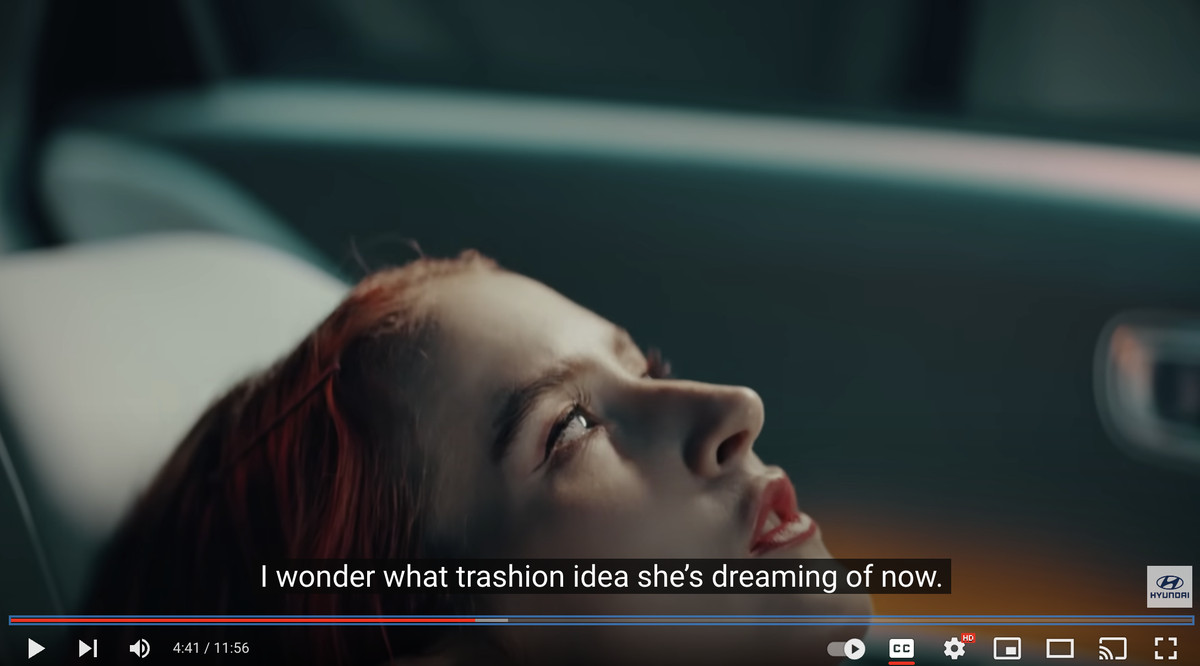New car events are usually pretty cringe, full of pointless pyrotechnics, emotionless futurescapes, shameless pandering to “the youth,” or hapless CEO antics. (Remember Elon Musk’s Cybertruck window smash fail? Simpler times.) So it is with some degree of hesitation that I must point you to this video from Hyundai as the latest exhibit in this ongoing series of “car companies present depressing visions of the future.”
The video, which was released yesterday, was intended to reveal the sleek-looking Ioniq 6, Hyundai’s latest electric vehicle with a 77.4kWh battery and 379 miles of range. Instead we got a smorgasbord of buzzwords — “trashion,” metaverse, NFTs — ideally aimed at appealing to a youthful demographic, but going about it in the worst possible way.
In the video, we’re introduced to an artist named Mia who’s putting on a “trashion show.” So relatable! For those not in the know (like me), trashion is the art of repurposing waste and recyclable materials — basically trash — as fashion. I’m not opposed to this, but I do question whether a trashion artist like Mia can afford a brand new electric vehicle, given the horrific dealer markups we’ve been seeing and the unsustainable loads of student debt people in her demographic are laboring under. But I digress.
Mia uses her Hyundai Ioniq 6 to traverse the eerily traffic-less landscape looking for bottle tops and tarps she can transform into dresses and rompers and shit. None of this is particularly objectionable on the surface: Gen Z stand-in with an unclassifiable career who loves zero-tailpipe emissions! You can see how that probably adds up in the eyes of the faceless Hyundai execs who greenlit this production.
But things quickly take a dark turn for Mia. It is revealed that her hectic schedule — Is she self-employed? It seems likely, but goes unmentioned — doesn’t allow her enough time to take breaks, forcing her to sleep in her car.
Hyundai claims the Ioniq 6 is the ideal place for a nap, calling it a “mindful cocoon” for single, young urban professionals. The interior is packed with sustainable materials and dramatic lighting, with 64 colors from which to choose. The automaker says it was designed to be a “healing space” with its “relaxation seats” and “speed sync lighting.”
:no_upscale()/cdn.vox-cdn.com/uploads/chorus_asset/file/23844033/Screen_Shot_2022_07_14_at_12.56.53_PM.png)
Setting aside whether Mia could get away with sleeping in her car without getting slapped with a ticket for vagrancy, the vision of the future that’s on display in this video isn’t the idealization of freedom that Hyundai thinks it is. To me, it conjures up images of Uber drivers and other aggrieved gig economy workers forced to sleep in their cars to make a decent living. Images of millennials and Gen Zers being forced to work long hours in service of “the grind” and other bullshit capitalist concepts.
So with that in mind, it should come as no shock Mia’s trashion show won’t be an IRL event, but rather in the metaverse. That’s right: her fashion ambitions don’t seem to include the design and creation of actual, IRL clothes, just outfits for virtual minifigs. Why else would she be doing all that driving?
Another character in the Hyundai video, a “social content creator” named Joan, straightens her hair using her EV’s many USB plugs as she gets ready to livestream about the VR trashion show. Again, we’re presented with another “hustling” Gen Zer who doesn’t have time to use her own bathroom to prepare — assuming she even has a bathroom to use.
Like other car companies before it, Hyundai sees its latest EV as less a blunt tool to get from point A to point B, but an idealized “space” for a whole panoply of activities. This touches on the notion of what we choose to do with our time while being driven to our destinations in electric and autonomous vehicles. And it has sparked a weird, little-noticed movement in the technology and auto industries to redefine automobiles as social environments on par with our homes and work places, a space also known as the “third place.”
The concept of the “third place” has been around for decades, but was probably best articulated by urban sociologist Ray Oldenburg in his 1989 book The Great Good Place. In it, he wrote that third places all over the world share common and essential features.
:no_upscale()/cdn.vox-cdn.com/uploads/chorus_asset/file/23844042/Screen_Shot_2022_07_14_at_12.57.34_PM.png)
“The eternal sameness of the third place overshadows the variations in its outward appearance and seems unaffected by the wide differences in cultural attitudes toward the typical gathering place of informal public life,” Oldenburg wrote. “The beer joint in which the middle class American takes no pride can be as much a third place as the proud Viennese coffeehouse.”
Typical third places include barber shops, cafes, parks, clubs, or even Starbucks. But can cars, with their enclosed environments, no fixed location, and demands on our attention, be considered a third place? It’s a pretty bleak idea, when you consider all the negative externalities, like traffic congestion, pollution, and death. But that won’t stop Hyundai from pitching their new EV as a viable third place, complete with mood lighting befitting a new generation of social media influencers.
